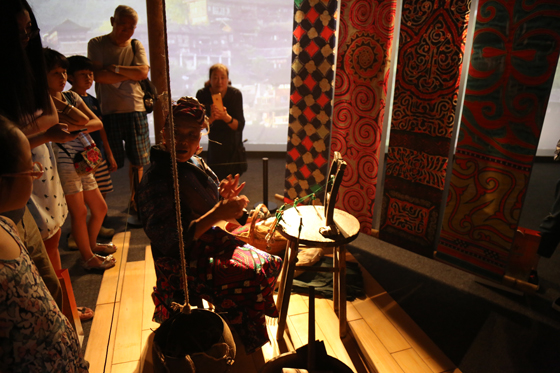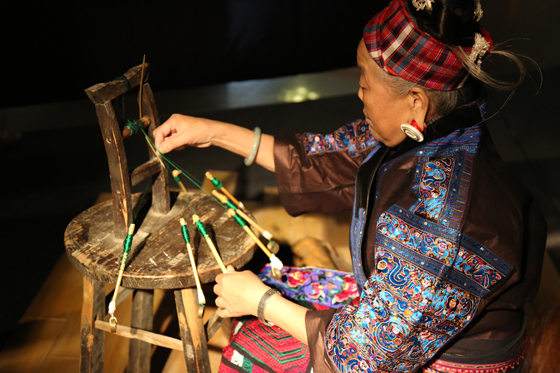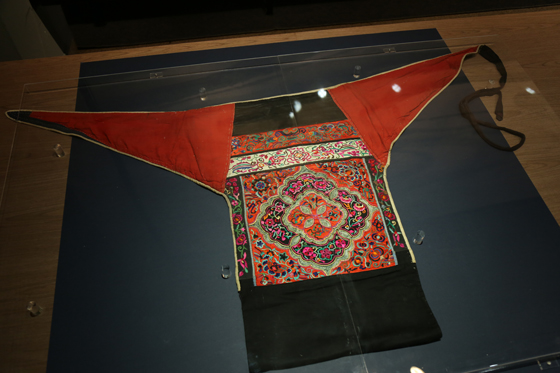Attachment to the Hometown——Exhibition of Selected Baby Carriers from Ethnic Groups in Southwest China Donated by Li Huizhen opens in NAMOC
Source:: Time:2016年09月23日
Attachment to the Hometown -- Exhibition of Selected Baby Carriers from Ethnic Groups in Southwest China Donated by Li Huizhen was unveiled in the National Art Museum of China (NAMOC) on August 19, 2016. The donation was a National Arts Collection and Donation Reward Program, jointly established by Ministry of Culture and Ministry of Finance. It was an affirmation and honor of the country towards Li Huizhen for her selfless contribution. The collection of the precious baby carriers also highlighted NAMOC’s high attention to the intangible cultural heritage and respect of the folk arts.
Sponsored by NAMOC, the exhibition showcased exquisite baby carriers from eight ethnic groups in over 20 regions in the four provinces in southwest China. It was a gorgeous feast of national art for audiences. These precious national artworks were donated by Li Huizhen, vice-chairwoman of Hong Kong Fu Hui Education Foundation. Having collected a large number of baby carriers from ethnic minorities of southwest China from overseas areas, she donated 1,770 pieces among them to NAMOC. Donation of quality folk fine artworks at such a large scale was a great contribution to the country, people and protection of national cultural heritages. NAMOC curator Wu Weishan said, “NAMOC takes the cause of beauty as a lofty mission. While we collect the works of beauty, we have also received good intentions.”
The donated works exhibition focused on the theme of “Our Love of Villages”. With the baby carriers of superb skills and exquisite decorations, it enabled audiences to appreciate the magnificent ethnic art woven by ethnic minority women of southwest China with good feelings and maternal love. It also illustrated Ms. Li’s humanistic feelings and sincere patriotic feelings in her generous purchase of these collections and selfless donation to the country to benefit the people. Like a colorful link, she joined up the feelings of southwest China villages and the Chinese people at large.
OVERSEAS TREASURES RETURNED TO MOTHERLAND
Ms. Li Huizhen is vice-chairwoman of Hong Kong Broadway Photographic Equipment Co, Ltd., chairwoman of Broadway Charity Fund, and vice-chairwoman of Fu Hui Education Foundation. She has participated in social and public welfare undertakings and volunteer works for 20 years. She travelled for tens of thousand miles in a dozen of times, at her own expenses, between Canada and Sichuan Taliang Mountains, extending motherly warmth to countless orphans and students from poverty-stricken families in Liangshan. During the devastating Wenchuan earthquake in 2008, she donated materials to the value of 10 million yuan. In light of her love of Chinese culture, and pity for large amount of Chinese cultural relics lost to overseas areas in recent years, she, along with her good friend Professor Li Meixian from University of Hong Kong, bought a batch of baby carriers, of ethnic minorities of southwest China, from collectors in the United States, and donated 1,770 pieces, the largest ever in number, to NAMOC for permanent collection. These baby carriers came from eight ethnic minority groups from Guizhou, Hunan, Guangxi and Yunnan. In particularly, the largest number, and also richest in varieties, was baby carriers of Miao Minority from Zhijin, Nayong and Qianxi of Guizhou province. They were products from late Qing Dynasty to the 1980s. Many precious embroidery treasures are non-renewable.
Ms. Li Huizhen, with her benevolent deeds, brought a large number of embroidery artworks of Chinese ethnic minorities lost overseas back to the country. This is of extraordinary significance. It added a bright stroke to the NAMOC in its collection of embroidery artworks of ethnic minorities. Meanwhile, NAMOC will prove itself the best place to host these lost cultural relics.
LARGEST EVER BABY CARRIER DONATION
Baby carrier, also known as “baby back strap”, is a belt that ethnic minority women apply to carry their baby on the back when going to market or working in the field. It is not only an article of utility, but also a shield to protect young baby, and more importantly, a close link of mother and baby. As a result, baby carrier is decorated exquisite and beautiful under great maternal affection. Produced under the techniques of weaving, embroidery, dyeing, embedding and sewing, baby carriers are lovely picture scrolls woven with love, in terms of color matching and plastic arts. They manifest the splendor of maternal love and superior skills of women, a concentrated exhibition of the culture and art of ethnic minorities in southwest China. Following social and economic progress and modernization process, these charming baby carriers and costumes will become even more precious.
Baby carriers are important articles of daily use of ethnic minority laboring women in southwest China. They are also tangible carriers of the aesthetic standards, values and world outlook of the ethnic groups. With their bright minds and ingenious hands, the women have melted their care of life, memory of ancestors and love of all things on earth into the tiny baby carriers. A thorough understanding of them makes out the spirit, history, culture and emotion of the ethnic groups. The baby carriers of the ethnic minorities, represented by Miao and Dong, are decorated respectively with patterns of their worshipped fish, tung tree flower, pomegranate; and banyan tree flower, chaos flower and spider, which are metaphors of intersection of yin and yang, luxuriant foliage, and carrying on the family line. Meanwhile, some ornaments are added, such as perfume satchel, tassels and sequins, also for avoiding evil spirits from the babies. Ethnic minorities in the southwest largely do not have their own writing system. Memory of their history mainly comes from stories, legends and poems passed down orally, and in pictographic characters including costume patterns, popularly known as “history books worn on the body”. In the baby carriers of the Miao ethnic group, the abstract ornamentations, termed as mi mai and lang wu, indicate the course of the Miao people migrating southward across mountains and rivers. These weighty memories are abstracted to freeze upon the baby carriers, for edifying the younger generation and passing on the culture and history of the ethnic groups.
SPLENDID EXHIBITION
Strolling in the exhibition hall, audiences will feast their eyes on dazzling baby carriers of radiant splendor and rich national features, as if placing themselves in a treasure house of the embroidery art. In the central exhibition hall in the fifth floor of NAMOC building, audiences will feel they are exposed to the stockaded villages of the southwest, in view of the elegant indigo blue setting, giant Guizhou Miao village pictures, wooden structure simulated Dong dwellings, and exquisite back carriers hung on bamboo poles. The exhibited antiquated Miao looms, tape holders, vegetable dyes and embroidery tools enable audiences to have perceptual intuition and comprehensive understanding of the exquisite craftsmanship infused with great maternal love. The exhibition hall also displays back carrier models, allowing audiences to have a try personally.
The exhibition puts on display 150 pieces selected from Ms. Li’s donations. It is a journey of the visual beauty of the folk art, as well as a showcase of love and dedication. As Wu Weishan put it, “The most beautiful in the world is family love. The loveliest in the world is maternal love! When mothers embroider such feelings and love with needle and thread into beautiful patterns, they are beauty upon beauty, the loveliest in the world!” NAMOC hereby extends special thanks to Ms. Li for her selfless dedication. Her patriotic behavior makes it possible for us to appreciate so many charming artistic works. It also calls forth more people of insight to contribute their love to the collection of artworks in the country.




